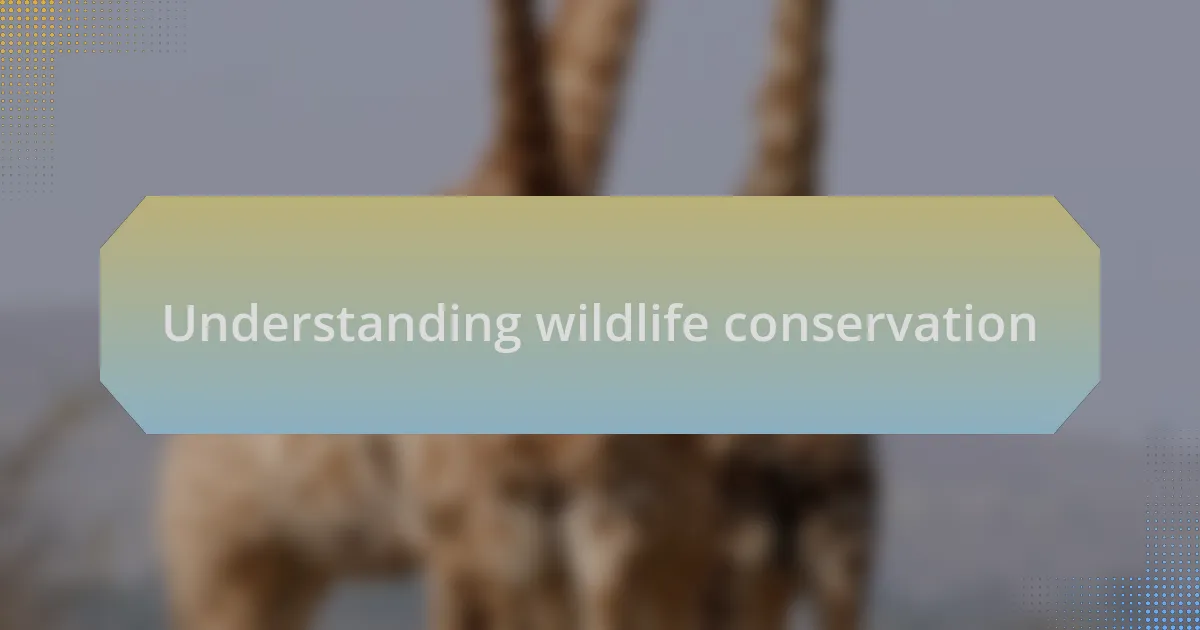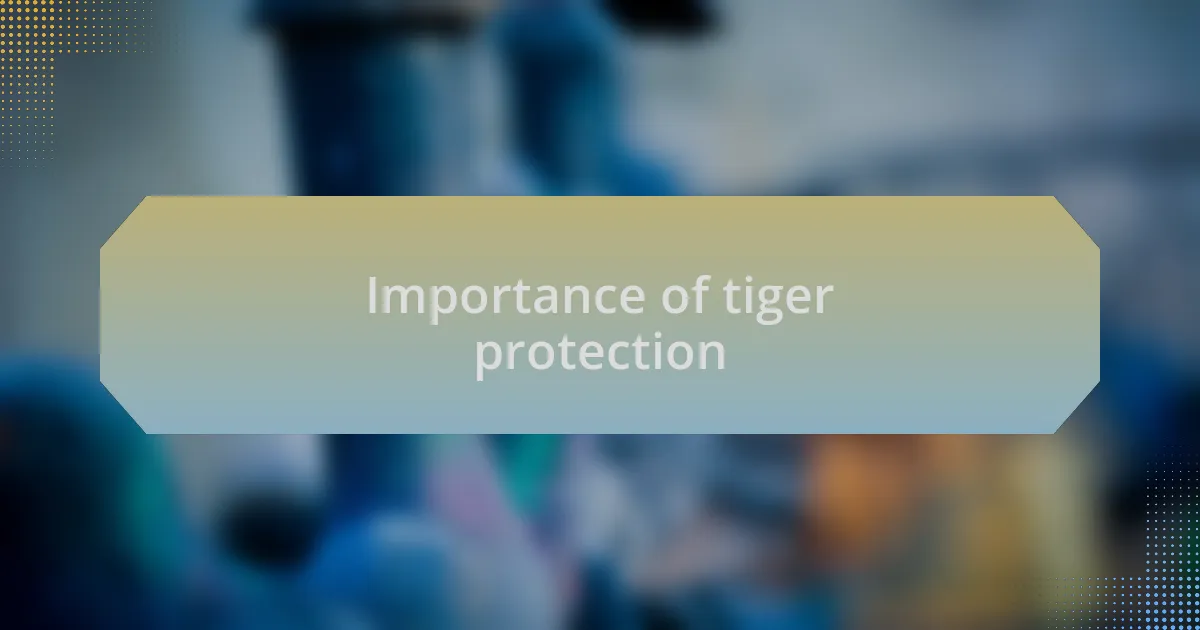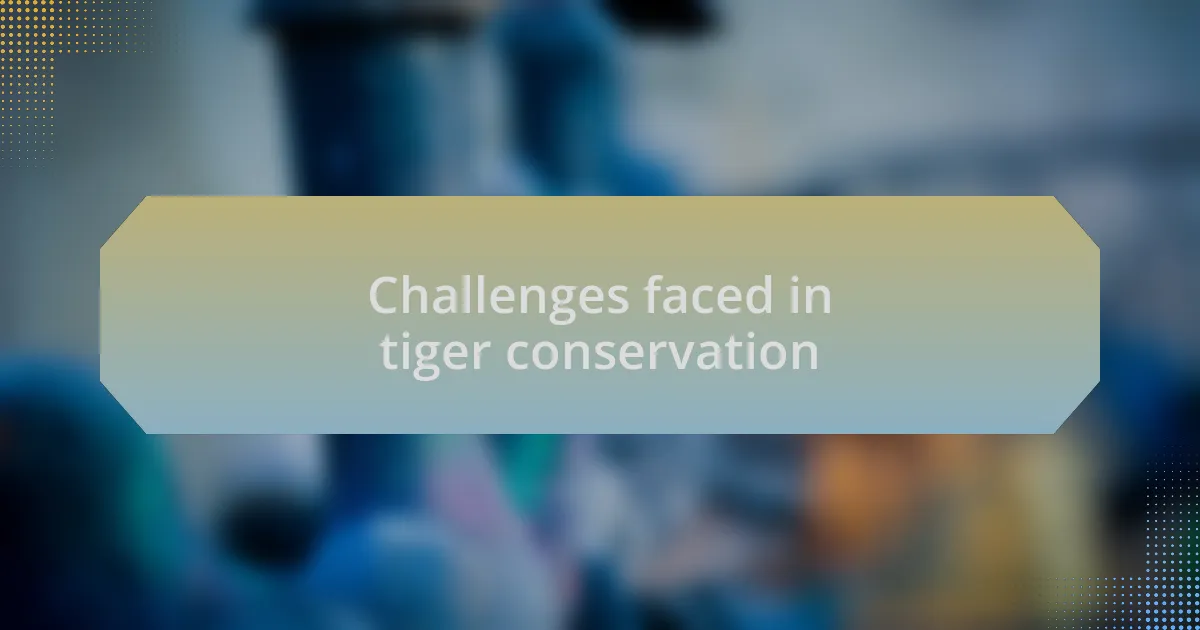Key takeaways:
- Wildlife conservation involves preserving ecosystems, emphasizing the interdependence of species and the necessity of community involvement for effective strategies.
- Tigers serve as umbrella species, whose protection is crucial not only for their survival but also for maintaining ecological balance and benefiting other wildlife.
- Volunteering in tiger protection offers diverse experiences, fosters community engagement, and highlights the importance of education in addressing conservation challenges.
- Challenges like habitat loss, poaching, and health issues in tiger populations require collaborative solutions that involve local communities to ensure sustainable conservation efforts.

Understanding wildlife conservation
Wildlife conservation is about more than just saving animals; it’s a deep commitment to preserving the ecosystems they inhabit. I remember my first encounter with the forest while volunteering for tiger protection. The air was thick with the scent of wet earth and leaves, and I couldn’t help but think: how would we feel if we lost this vibrant space to neglect or development?
When I immersed myself in conservation efforts, I realized that every species plays a critical role in its environment. Losing one can create a domino effect, disrupting entire ecosystems. This idea hit me hard during a discussion with fellow volunteers, as we shared stories about our experiences and the animals we had encountered. It made me question, what would our world look like without these incredible creatures?
Conservation is also deeply intertwined with community and cultural values. In some areas, local communities depend on wildlife for their livelihoods, which brings a unique layer of complexity to conservation efforts. I found it fascinating to see how respecting these connections can lead to more effective protection strategies. It reinforced my belief that conservation should be a collaborative journey, uniting people and nature for a common purpose.

Importance of tiger protection
The importance of tiger protection goes beyond the preservation of a single species; it is about maintaining the balance of the entire ecosystem. One vivid memory I have was witnessing a mother tiger with her cubs in the wild. Their graceful movements were a reminder of the beauty and power these animals possess. I couldn’t help but wonder, how crucial is their role as apex predators in maintaining the health of their environment? Their presence regulates populations of other species, ensuring that ecological balance is sustained.
Tigers are often considered umbrella species, meaning their protection shields numerous other wildlife species and habitats. I recall a conversation with a wildlife ranger who explained how safeguarding tiger habitats automatically benefits the countless other life forms that share that space. It made me reflect on the interconnectedness of nature — if we lose tigers, do we not risk losing so much more? The thought was unsettling and underscored the broader ramifications of their decline.
Moreover, tigers symbolize strength and resilience in many cultures, making their protection a vital aspect of preserving natural heritage. During my volunteering journey, I met indigenous community members who shared stories of their ancestors revering tigers as powerful beings. Their deep connection to this majestic animal brought me immense respect for the cultural significance of tigers. Isn’t it fascinating how the stories we tell about wildlife resonate on such a personal level, binding us all in a shared narrative of coexistence?

Overview of volunteering opportunities
Volunteering opportunities in tiger protection are as diverse as they are impactful. From hands-on fieldwork to educational outreach, each role plays a critical part in fostering awareness and conservation efforts. I remember my first day volunteering with a team monitoring tiger populations; the thrill of tracking their movements through the forest made me realize the real-time difference we can make.
One particularly rewarding aspect of these opportunities is engaging with local communities. I found that working alongside villagers not only helped us implement sustainable practices but also created lasting bonds. When discussions about tiger protection turned into shared meals and stories, it deepened my understanding of how essential community involvement is in conservation efforts. Have you ever considered how collaboration can lead to more effective outcomes in environmental initiatives?
Moreover, many organizations offer remote volunteering roles, allowing those with limited time to contribute. Whether it’s conducting research from home or supporting social media campaigns, these options can still make a significant impact. I remember the sense of accomplishment I felt when my outreach efforts led to increased community engagement online; it reinforced my belief that every contribution counts, no matter how big or small.

My personal motivation to volunteer
Volunteering in tiger protection became a personal mission for me when I learned about the alarming decline in their populations. I still vividly recall attending a seminar where a conservationist shared heartbreaking stories of tigers facing habitat loss and poaching. It struck a chord deep within me, igniting a passion to take action and contribute, even in a small way.
I often ask myself what legacy I want to leave for future generations. Seeing my young niece express awe for wildlife during our nature hikes inspires me to fight for the creatures that could one day vanish. The hope that my efforts could ensure she grows up in a world where tigers roam freely fuels my desire to volunteer and educate others on the importance of these majestic animals.
One moment that stays with me was when I shared the story of a community hero who dedicated his life to tiger conservation. I felt a surge of motivation knowing that if one person can make such an impact, then maybe I could be that spark in someone else. It’s this belief in the potential for collective change that drives me forward, reminding me that my contributions, no matter how small, have the power to inspire others.

Experiences gained while volunteering
While volunteering for tiger protection, I gained invaluable insights into the complex relationship between wildlife and local communities. I remember walking through dense jungles alongside villagers who shared their challenges regarding livestock predation by tigers. Their stories made me realize that conservation must balance wildlife needs with human livelihood—that engagement and education are key to finding workable solutions.
One particularly eye-opening experience was when I helped organize a workshop on tiger tracking. As I attempted to master the art of reading paw prints, I felt a deep connection to the land and its inhabitants. It was a moment of humbling realization; I wasn’t just learning about tigers—I was becoming a part of their story. How often do we get the chance to connect with nature on such an intimate level? This experience fostered a profound respect for the sheer resilience of both tigers and those who protect them.
Through these experiences, I’ve also developed stronger teamwork skills and the ability to adapt quickly to unforeseen challenges. I can still recall a day when a sudden rainstorm disrupted our plans to set up camera traps. Instead of feeling disheartened, we rallied together, finding creative ways to shelter our gear while continuing our tasks. It taught me that in conservation, as in life, flexibility is vital. What I learned during these moments isn’t just about tiger protection—it’s about resilience, camaraderie, and a commitment to making a difference, no matter the obstacles we encounter.

Challenges faced in tiger conservation
The challenges faced in tiger conservation are diverse and complex. For example, habitat loss due to human encroachment is a dire issue. I once visited a region where dense forests were shrinking rapidly, replaced by agricultural land. Watching villagers cut down trees made me ponder: how do we convince them to preserve this habitat for tigers while ensuring their livelihoods?
Another significant challenge is poaching, which threatens tiger populations across the globe. I recall a chilling encounter with a ranger who revealed that just weeks earlier, they had discovered a snare meant to trap tigers. His eyes were filled with a mixture of anger and sadness, reflecting the stark reality of protecting these magnificent creatures. How can we combat this menace if communities aren’t engaged in conservation?
Finally, health issues in tiger populations can complicate conservation efforts. During my time volunteering, I learned about various diseases affecting these animals, particularly in fragmented habitats. It struck me that if tigers can’t move freely to find mates or new territories, their future is even more uncertain. This realization left me questioning: what strategies are we employing to ensure genetic diversity and health in tiger populations? Each of these challenges underscores the intricate web of factors that conservationists must navigate, compelling us to rethink our approaches.